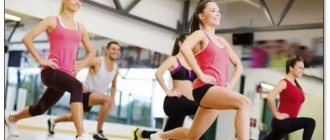In 1968, American Air Force Colonel Kenneth Cooper developed an exercise technique he called aerobics. He also published a book where he explained in detail what exercises should be performed and how they should be performed. But the whole world learned about aerobics thanks to the American fashion model and actress Jane Fonda. It was this woman who combined classical aerobics with music. Although the basic movements from Cooper's book were taken as a basis, the actress supplemented them with her own developments. She published a book and a large number of videotapes, where she told and showed all the basic aerobics movements.
Classical aerobics - basic movements
If we consider all the steps, they are tied to the beat of the music on two or four counts. This is a classic movement that can be connected in eight bars, sixteen and thirty-two. It is quite difficult for beginners to immediately master multi-beat steps, so the coach pronounces the steps at each training session, and always conducts very complex combinations together with the students. But basic steps are the basis of all aerobics movements. This can be compared to the ability to read; if you don’t know the alphabet, it means you can’t read.
Classic aerobics uses two main steps:
- Movements in which the leading leg does not change. That is, with which leg you started the movement, all subsequent combinations also begin with this leg.
- With a change of leading leg. That is, each subsequent step begins with a different leg.
As mentioned above, all steps are performed in only two or four beats.
Step aerobics - fitness with strength and aerobic exercise
Necessary equipment: step platform, dumbbells. All this is inexpensive and you will need it to perform a set of strength exercises.
The advantages of this type of active fitness:
- Strengthening muscles without enlarging them;
- Cardiovascular training;
- A combination of aerobic and strength exercises;
- Increased energy consumption (600 kcal per hour);
- Does not require knowledge of dance elements and developed coordination;
- It helps to practice basic movements well.
Contraindications to such activities:
- Varicose veins in all stages, predisposition to this disease;
- Hypertension and high body weight are a reason to choose lower-intensity exercise;
- Problems with the spine.
Movements without changing legs
Almost all movements of the first category are performed in four beats. Each movement has its own name.
March
These are the usual steps on site. Alternate steps are taken with different feet for four beats. For example, a right step, a left step, then again a right step, a left step.
Mambo
This type of movement repeats the previous one with a small addition in the form of moving the leading leg forward, then back. That is, take a step forward with your right foot, with your left foot in place. Then right back, left in place. The leg extension can also be done diagonally. This is a variation of this movement.
V-step
These movements received this name due to the similarity of the pattern on the floor that the legs make. If the right leg is leading, then its movement begins forward and to the side (to the right). Next, left - forward and left. Then the right leg begins the same movements in the opposite direction. That is, you return to the original point. Please note that the leading leg can be either the right or left.
Cross
These are the most difficult movements for beginners, because the legs have to be moved, crossing each other. The scheme is as follows: the leading leg (for example, the right) is placed forward and to the left, the left leg to the side to the left, the right leg back to its place, the left is placed next to the right.
Indications for fitness training
Aerobics is not only a popular fitness area for weight loss. This is also a type of active gymnastics, which doctors often recommend to patients with various ailments.
The list of indications for aerobic fitness training includes:
inactive lifestyle, causing stagnant diseases; rehabilitation period after injuries and operations; prevention of heart and vascular diseases; high levels of obesity; regular fatigue, anxiety, sleep disturbances, depression; tension in the spine and lower back; low endurance.
Movements with alternating legs
Step aerobics movements with changing the leading leg occur in two and four beats. The number of beats will be indicated in parentheses next to the name of each movement.
Step-touch (2)
This is the simplest movement. Step one foot to the side, put the other one towards it. Now go in the opposite direction, changing legs. The next movement begins with the leg with which the previous movement was completed. There is a double Step-touch - this is a movement to the side twice. For example, the right foot is to the right, the left is placed next to it, another step to the right, the left is placed. Now in the opposite direction.
Step-tap (2)
These are touch movements. That is, the leading leg to the side, the second one must touch the floor before the first.
Chasse (2)
This is another step-over movement. Experts call them “with a broken rhythm.” The thing is that three movements are performed on two counts, the last two at a fast pace. The leading leg is to the side, the second is placed next to it, and the first leg must be taken in place.
Step-lift (2)
Here you will have to make swinging movements. The swing can be made in different directions, hence the varieties. The scheme is as follows: step to the side, the second leg must be swung either to the side (side), or forward (front), or back (back).
Step-kick (2)
Klik is a kick. The steps received this name due to their similarity with this movement. Leg to the side, the second is thrown forward and placed near the first.
Step-curl (2)
Overwhelming movements. Leg to the side, the second is bent back and placed behind the first, then placed next to it.
Step-plie (2)
These are squat movements. Step to the side, second leg straight, squat on the first leg.
Step-lunge (2)
Step forward, the second foot touches the floor behind the first foot.
Step-knee (2)
Step to the side, the second one bends at the knee.
Knee-up (4)
This is the same as Step-knee, only for four counts.
Grape-wine (4)
The name translated means grape wine. The scheme is as follows: step to the side, the other leg is placed crosswise behind the first. The first one is still to the side, the second one is placed next to it.
Knee
- Step right foot to the right.
- The left one moves towards her, while rising as high as possible to the chest, bending at the knee.
- The left one comes back.
- The right, moving towards the left, rises as high as possible to the chest.
Repeat 32 times.
Stay calm and carry on! How to force yourself to play sports Read more
1980s Workout: Fun Aerobics by Jane Fonda and Cindy Crawford
The COVID-19 pandemic leaves no choice (favorite fitness clubs and Pilates studios are closed), so workout videos that require only a yoga mat and a few free square meters in the living room are back at the peak of popularity.
While YouTube fitness channels and online personal trainers are booming, many fitness enthusiasts are delving into the archives, focusing on time-tested workouts from the 1980s and 1990s. We also decided to remember the legendary lessons of Jane Fonda, Cindy Crawford, Susan Somers, Heather Locklear and Cher. If you only have three minutes and 43 seconds and want to know everything about the 1980s, watch Olivia Newton-John's Physical music video.
In the video, the singer, wearing a sports tights, trains a group of men who, thanks to weight lifting and aerobics, turn into muscular handsome men. Who knew that this clip would define a trend for decades to come - fitness.
Jane Fonda
Decades before mileage-counting smartwatches appeared, the revolution came with the advent of VCRs and home fitness classes.
Fitness in the 1980s and 1990s was based on simple and, most importantly, safe aerobic exercises. The main components of a spectacular workout were a bright swimsuit, tights, leg warmers and headbands, energetic, simple movements accompanied by fiery music and, of course, a smiling presenter.
One of the first stars to record such a video (and spend mere pennies on it) was Jane Fonda. In 1981, she released an illustrated edition of The Jane Fonda Development Book, and a year later, a training disc.
It has sold over 17 million copies. Millions watched closely as the actress stretched, squatted and flexed her muscles in a striped swimsuit and lavender leg warmers. The tape became more popular than the films Star Trek II: The Wrath of Khan and An Officer and a Gentleman. Jane Fonda not only became famous as a fitness trainer, but also changed the industry of producing and selling video recordings. Before her, no one sold videotapes; they were rented.
Time magazine that year published a story of five people with photographs of them before they began training with Jane's system. It is believed that Fonda elevated aerobics to the rank of a national hobby, she was even nicknamed “Lady Aerobics” (in order to introduce as many people as possible to aerobics, including young people, the actress registered on the social network TikTok and revived her iconic home workouts in video format).
Two years later, Rachel Welch followed suit. In 1984, on the Beauty and Fitness program, she demonstrated how to tone the body by doing yoga. She also released a book detailing her fan program.
https://youtu.be/deKHYCsjseg
In 1991, Cher released her legendary video CherFitness. Unlike her colleagues, the star preferred to practically not comment on her movements. In the video, the star appeared in the iconic Turn Back Time costume - a black mesh swimsuit with sequins and a strap at the waist.
https://youtu.be/7uR_h2ePmjM
Cher
The concept of “supermodel training” originated with Cindy Crawford and Elle Macpherson. Crawford released a two-hour video in 1992, Shape Your Body, in which she appeared in a sports bra and shorts and presented a complex that combined both cardio and strength training.
Cindy Crawford
The video exercise complex “Ideal Body in 10 Minutes,” developed by the legend of the modeling business together with the popular star trainer Radu, is still wildly popular.
At first glance, athletic girls seductively explaining how to fit into a smaller dress might not seem to convey a feminist message. However, the explosion of home fitness videos in the 1980s was effectively an incursion into a traditionally male-dominated industry.
In 2020, Fonda re-released her acclaimed original workout on DVD. The star explained the success of her videos by the fact that previously most gyms were mainly for men. The actress is right—before pioneers like her and Judy Missett (founder of Jazzercise) came along, fitness was focused exclusively on bodybuilding. Activities in general were considered not a woman's business and intended mainly for professional athletes.
Thanks to Jane Fonda's workouts and other female-led video tutorials, many girls have been able to exercise in their own homes. Even if much of the world's VHS collection currently resides in attics or landfills, the retro-fitness aesthetic continues to influence pop culture.
Pastel shades like Cher, workout clothes in the style of the 1980s, wild curls, swimsuits with high slits - all this is more relevant than ever and evokes nostalgia for a bygone era. Let's remember Feeling Ok from Best Coast to the Fade video by Kanye West.
Cindy Crawford











